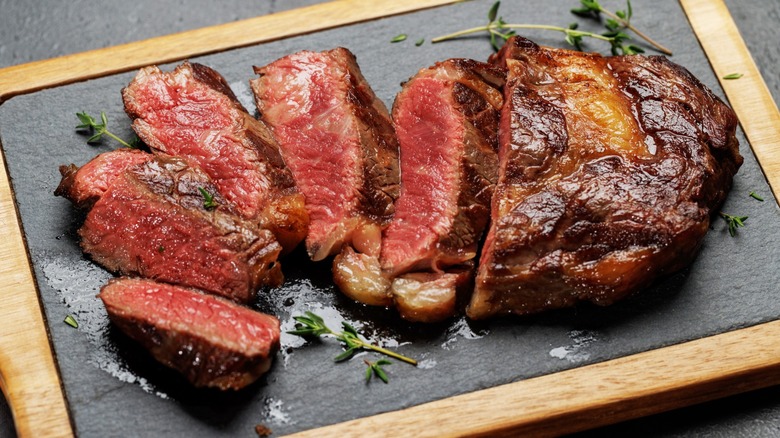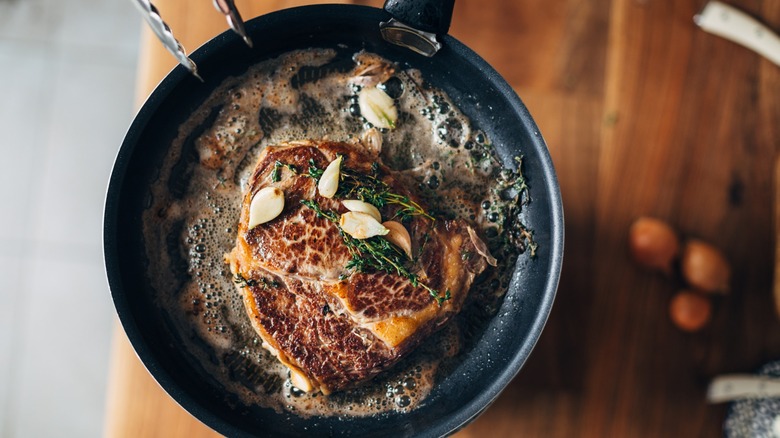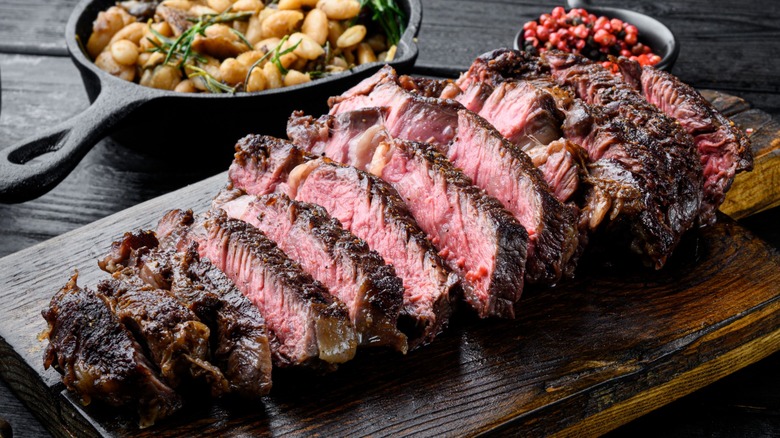What A Perfect Seared Steak Should Sound Like
Nothing satisfies the tastebuds quite like a perfectly executed, delectable, tender steak. The simple but effective blend of a well-established crust and a juicy middle may just be unmatched in the world of cuisine. However, achieving the perfect sear may seem daunting to some. Even if you may have seared your steaks in the past, the process might still come across as a tricky business to get exactly right.
Seared steak is, on the surface, a wholly simple process. You simply sear your piece of beef on both sides until a crust develops and you reach your desired level of doneness. But those who try this method find out pretty quickly that it may not be quite as simple as it first appears. Achieving the perfect crust on a steak can be a finicky business if you don't know what clues to be on the lookout for. There are certain tips on pitfalls to avoid to achieve a perfect crust, but one thing you may not consider is the sound your steak makes while it's in the pan. As it turns out, keeping an active ear on your steak may be just as important as keeping your eyes glued to your savory dish.
The skillets are alive with the sound of searing
How long you cook your steak will of course vary based on the cut you're using. But whether you're opting for a more beginner-friendly cut or a more prized selection, the temperature of your skillet will prove key to attaining the perfect sear. Depending on your level of kitchen experience, cooking at super-high temperatures may seem intimidating, but you'll need your skillet to be intensely hot in order to sear your steaks. This is because the Maillard reaction (the process by which seared meat attains its mouth-watering crust) only begins at temperatures above 280 degrees Fahrenheit.
You'll know your skillet is hot enough when your steak makes an angry, aggressive sizzle the moment you start cooking it. That's the Maillard reaction at work. Though there's a common thought that this searing technique is used to lock in moisture, you'll actually be searing away water from your steak when cooking this way. That screaming sizzle you're hearing? That's mostly water vaporizing from the surface of your steak. That relative lack of moisture on the surface is what will create a wonderful crust on your steak. A loud, almost alarming sear is going to evaporate the surface water and establish a satisfying crust, while a timid, whispering sizzle means your pan isn't hot enough and therefore won't properly evaporate the liquid in your pan. That low-profile sizzle won't create a dried, browned crust, since your steak will essentially be stewing in liquid. In this instance, then, loudness is your goal.
Seared steaks: a sensory experience
Your steaks will, in theory, continue searing loudly until all moisture is removed from the meat. This means you need to keep an eye out and flip or remove your steak once you've got a crust to your liking. A good crust not only gives you some wonderful textural variation from the rest of your steak, but the seared surface also gives you that delicious charred flavor that meat lovers crave so much. A mix of a drier seared surface with a tender, juicy middle is the ultimate goal for anyone embarking on this endeavor and is a great reward for a well-made dish. The aromatic qualities of a seared steak are also unmatched, especially if you bring some butter and herbs into the mix at the end stages of the cooking process.
All in all, a perfect pan-seared steak should be an experience that stimulates all of your senses, but pay special attention to that beautiful sizzling sound of an exceptional crust forming. Keep that sound of searing in mind as you perfect the method of pan-seared steaks.


